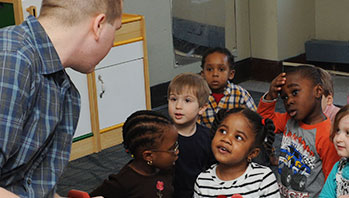- audio player
- chart paper
- marker
- variety of recorded instrumental music (quiet/soothing, slow/sad, dramatic/emotional, high-energy dance music, circus music, etc.)
- music
- musical instrument
- sound
MA Standards:
Speaking and Listening: SL.PK.MA.1 Participate in collaborative conversations with diverse partners during daily routines and play.
Head Start Outcomes:
Language Development/Receptive Language Attends to language during conversations, songs, stories, or other learning experiences.
Language Development/Expressive Language Uses language to express ideas and needs.
PreK Learning Guidelines:
English Language Arts/Language 2 Participate actively in discussions, listen to the ideas of others, and ask and answer relevant questions.
EEC Infant and Toddler Guidelines:
PW50. The older toddler engages in a variety of physical activities.
Talk Together: Move to Music

© Commonwealth of Massachusetts, Department of Early Education and Care (Jennifer Waddell photographer). All rights reserved.
STEM Key Concepts: Sounds vary in three ways: volume (loud or soft), pitch (high or low), and timbre (quality)
ELA Focus Skills: Creative Expression, Listening and Speaking, Vocabulary
Play one piece of music for children and ask them to listen very quietly to it. Ask children to describe the music. Ask questions such as,
- How would you describe this kind of music?
- What kinds of sounds do you hear in the music?
- Do you like it? Why or why not?
Encourage children to talk about sounds and any musical instruments they hear in the music.
Then focus children’s attention to how the music makes them feel. Ask, How do you feel when you are listening to this music? If children don’t have the vocabulary to describe how they were feeling, ask them to act out how they were feeling and help them find the words to describe their feelings. Record children’s responses on chart paper.
Social Emotional Tip: Asking children to describe their feelings helps build self-concept. Encourage all children to contribute a comment about how the music makes them feel.
